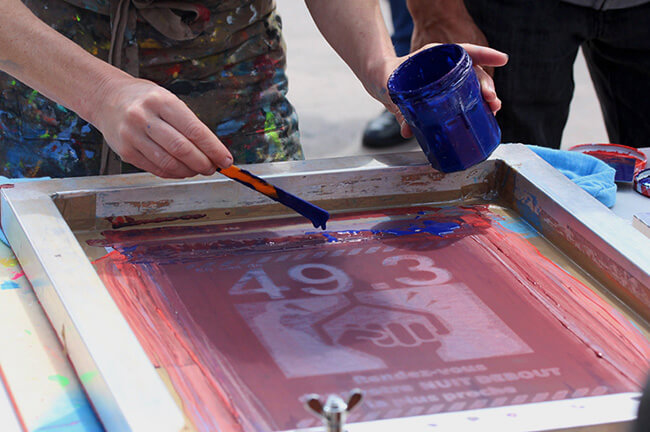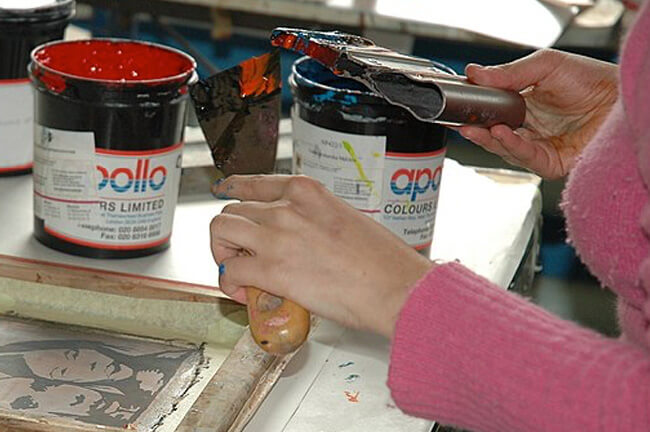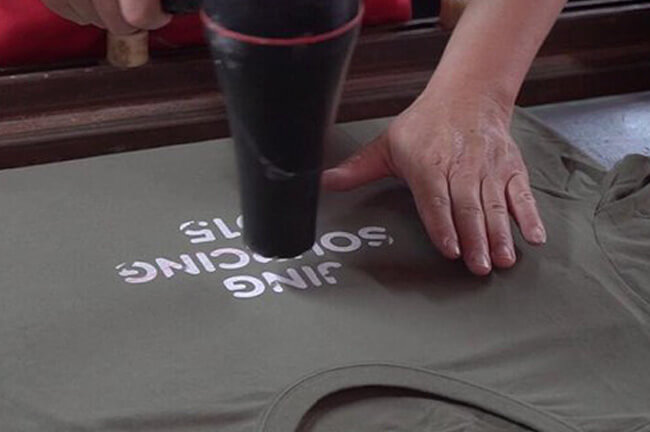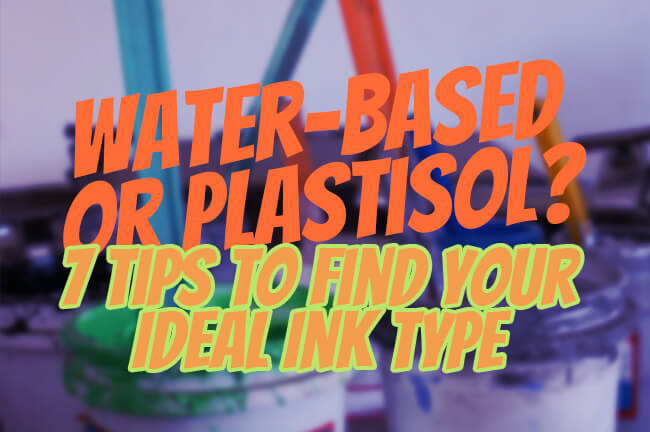If you’ve just started screen printing and want some suggestions for some decent inks to use for your project, you’ve come to the right place.
But if you’re expecting to tell you what the “best screen printing ink” is, you’re going to be disappointed. Because it simply doesn’t exist.
It’s like asking “What is the best car?”
What you need is going to be vastly different than me – and that’s the same with screen printing ink.
For some, hobby inks by Speedball works, but for someone more discerning, they wouldn’t be caught dead printing with them.
What I usually encourage folks in your shoes to do is try a few different inks.
But before you run out and make a purchase, you’ll need to make the crucial first decision between water-based or plastisol ink.
7 questions to find the screen printing ink of your dreams

Obviously, both water-based and plastisol inks have distinct advantages and disadvantages over the other.
Determining which one you’ll work with now will steer you in the right direction (and eliminate future headaches)
So today, we’ll highlight a series of questions to hopefully lead you to make a solid decision.
Where do you live?
Believe it or not, the weather plays a significant role in printing.
Not only does it affect the inks you use, but changes in temperature and humidity will have an impact on your overall processes.
For example, if you live in a place that gets quite hot, it might be easier working with plastisol inks as the temperature keeps it in an ideal and manageable state.
On the other hand, if you live in a freezer for the majority of the year, avoid plastisol as the viscosity increases (does not flow well) – making it difficult to print manually.
Similarly, printing in a dry climate on high elevation might be problematic for water-based inks because of how fast it dries.
To top it off, high humidity levels will also affect the ink’s performance (alters ink consistency), curing time (garments take longer to cure) and can even contribute to how well or how bad emulsion works. On the flip side, if your place is dry, utilizing a humidifier can help while working and storing inks.
Now you see, knowing your environment will not only help you choose the right inks to use, but it can also help with preparation, proper storage and ink maintenance.
What’s your skill level?

If the above environmental conditions allow, and you haven’t been screen printing much (or none at all), I suggest starting off with plastisol inks.
Often referred to as the “lazy man’s” ink, plastisol is easier to manage as it doesn’t dry on the screens while printing. Plastisol inks are oil-based so you can literally let it sit in an open paint tub almost indefinitely.
For a long time plastisol has been a popular choice for first time-solo printers.
However, these days many are also starting with water-based inks. I did so a decade ago but only because I was given a whole bunch of free supplies.
Having done both, I’m just advocating the easier route because most people tend to quit when they encounter a roadblock. Hopefully at the end of this article you’ll know which is right for you.
Now in comparison, water-based inks will start to air dry almost immediately. So once you start printing, you cannot stop until the entire job is done.
This makes it especially difficult when printing multiple colors. For example, say a problem arises with one of the screens, now you need to pull the other screens and make sure they don’t dry out.
This can cause delays (not to mention mental health stress) as you need to re-register or re-align all screens again.
There are ink manufacturers these days that sell additives which you can mix into water-based inks to mimic the drying characteristics of plastisol ink, but that means an additional variable which might not be convenient to some.
Do you currently own any equipment?
In order to achieve a durable and long lasting print, both inks need to reach a specific temperature, also known as the curing temperature.
Typically, plastisol inks cure between 280-320 degrees Fahrenheit while water-based inks cure higher at 330 degrees. Having said that, water-based inks start to air-dry almost immediately.
But keep in mind, drying and curing are two completely different things in screen printing.
Dry ink does not fuse with the fabric of the garment, curing does. And it’s required if you want your print to retain its vibrancy for many years to come.
Now back to the question.
If you don’t already have a heating element that can cure ink, for example a heat gun or heat press machine, your best bet is to start with plastisol inks.
Not only is it easier to work with, curing plastisol requires only a brief moment.
With water-based inks, curing temperature must be reached and then held on until all of the solvent (water) is removed – 2 minutes or more.
But what about hair dryers or irons?

These diy-home heating tools have been the staple of many Youtube tutorials and they do work, but only if you’re printing up a few t-shirts for yourself and maybe grandma.
Read more: 7 Ways to Cure Screen Printed T-shirts Like a Pro
Getting into production is where things become tricky, which brings us to our next question.
What is your budget?
While screen printing can be done either on the cheap or with a bank loan with interest, how you approach it depends on your personal goals.
If you want to screen print a few t-shirts for friends and family and keep it as a weekend hobby, starting with plastisol inks might be for you as they are generally cheaper than water-based inks.
To add, plastisol is also more forgiving screen wise when you’re in practice mode. With that said, pair it up with a decent heat gun and temperature gun and you’re all set to custom make gifts and presents!
If you’re thinking about going the commercial route, then definitely check out water-based inks as I believe it will take over plastisol inks.
What kind of print do you want to achieve?
When it comes to characteristics of the ink – vibrancy and “hand” (smoothness of the print) are the two most common differentiators.
Water-based inks produce a soft-hand feel – one that you can hardly notice from print and garment. This type of feel has been quite popular in recent years as fashion brands have been all about the vintage and distressed look. The compromise for this style is less opacity and a less vibrant print.

Compare this to plastisol inks, of which the “hand” is instantly obvious and works great especially for sports apparel.
Plastisol inks contain PVC or plastic agents making it extra durable and vibrant and these days, you can get nearly the same look and feel as water-based ink by adding a curable reducer.
What are your designs like?
Are you printing for yourself or do you have clients? What kind of effects and feel are you going for? Are your designs simple 1 and 2 colors, or photographic images?
If you’re printing for the outdoor market, chances are you’ll want plastisol inks as it’s easier to work with on polyester, sports apparel or when you want big blocks of solid, opaque color.
On the flip side, if you or your clientele are after that vintage look or want the impression that their clothes are made in an eco-friendly way, then water based inks are the way to go.
Either way, there are many more specialty effects that can be produced these days to cater to every type of style – discharged, glitter, puff and even glow-in-the-dark, so it’s best to narrow down to your needs at this point.
Which screen printing ink is more environmentally friendly?

The answer is water-based inks of course! It’s even got the word ‘water’ in it. Or so you would think.
Truth is, it’s more complicated than that and if you believe printing with water-based inks mean you are 100% eco-friendly, you’re wrong.
Still a common misconception as ‘safer’, many printers still do not account for the use of hazardous cleaning and reclaiming chemicals in water-based printing.
And even if biodegradable cleaning products are utilized, fact is, the ink’s pigment and inclusive additives are still very much toxic.
At least 15-30% of water-based inks have toxic components which are so fine they can’t be filtered out by the local municipal waste systems. This shockingly goes back into the public water supply and into our homes.
So going ‘green’ isn’t just about which ink you use, it’s about the entire setup and process.
Fortunately, the demand for eco-friendly inks are on the rise which has lead to some promising results in research and ink tech.
Soy-based inks have been getting a lot of good press lately especially with the adoption from big labels like Nike and Adidas.
These inks feels and perform just like regular plastisol – has the same consistency, produces a soft hand and is stretchable. And although it’s more pricey, it is the way forward.
The Good, Bad and Ugly of Water-based and Plastisol inks

Experts who have been screen printing for a long time realize that there isn’t really a line between good and bad, it’s all about what you need to accomplish with your prints.
If you have been reading up to this point, you should have an idea of which ink you should work with. To sum it up:
Water-based inks
- can be difficult to work with depending on your experience and skill
- produces a super soft “hand” that most customers prefer
- steep learning curve to master
- embeds in the fibers for good durability
- will air dry immediately – also perfect for use on paper like posters and card stock.
- has a wide range of options for other specialty printing e.g. discharge
- more expensive than regular plastisol
- more eco-friendly if proper cleaning materials are used
- once you start a job, it’s problematic to stop and then start again.
- lack of opacity may require multiple prints
- good on nearly any fabric if the correct ink and techniques are employed.
- more demand from consumers because of trends
- new inks have more superior feel and breathability
Plastisol inks
- never dries, needs to be cured.
- laziness factor – can be left in the screens and will be fine when you get back to it.
- able to print glitter, foil, flock and puff
- can be printed on a specialized heat transfer paper called plastisol transfers
- able to print wet-on-wet, saving on cleanup time and chemicals.
- works on almost any garment type and color type.
- requires less heat/electricity for curing
- produces vibrant and opaque prints
- leaves a “hand” after printing
- the garment decoration industry is stopping PVC-based inks as it’s less sustainable
- no longer aligned with market expectations and regulatory trends
List of Water-based or Plastisol Inks to get started with
Here are some approved inks that have been vouched for by the screen printing community.
Since each manufacturer has their own ink mixing methods with unique characteristics, I suggest testing a few to find the best one that suits you.
Water-based inks
- Speedball Fabric Screen Printing Ink Starter Set
- Jacquard Textile Inks Textile Color Fabric Paint
- Virus Inks
- Green Galaxy (rebranded Matsui inks)
- Permaset Aqua and SuperCover
Plastisol inks
Eco-friendly inks
If you’re environmentally conscious and want to do your part, get started with some eco inks.
- Soymax (soy based inks)
- Algae ink by Living Ink
- Matsui RC Eco-Series
Next steps
My hope is that you’ve gotten some good information to confidently move forward.
Determine your goals first and then start slowly to gradually test out different inks. As mentioned previously, there is no “best”.
Even experienced printers who have been in the game for years carry 3-5 different brands because each ink gives them different results. This is the only way to succeed – by learning the traits and behavior of that different ink types.
Just remember, a good screen printer can make mediocre inks look good on a t-shirt while a bad printer can make top-notch ink look bad.
Focus on the technique and you won’t go wrong!

